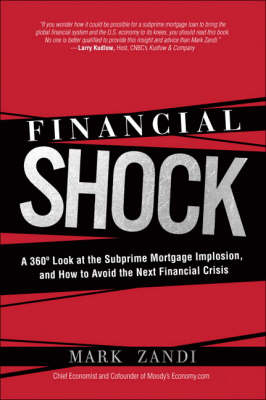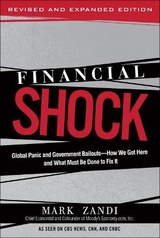
Financial Shock
Financial Times Prentice Hall (Verlag)
978-0-13-714290-3 (ISBN)
- Titel erscheint in neuer Auflage
- Artikel merken
—The New York Times
“In Financial Shock, Mr. Zandi provides a concise and lucid account of the economic, political and regulatory forces behind this binge.”
—The Wall Street Journal
“Aggressive builders, greedy lenders, optimistic home buyers: Zandi succinctly dissects the mortgage mess from start to (one hopes) finish.”
—U.S. News and World Report
“A more detailed look at the crisis comes from economist Mark Zandi, co-founder of Moody's Economy.com. His “Financial Shock” delves deeply into the history of the mortgage market, the bad loans, the globalization of trashy subprime paper and how homebuilders ran amok. Zandi's analysis is eye-opening. ... he paints an impressive, more nuanced picture.”
—Kiplinger's Personal Finance Magazine
“If you wonder how it could be possible for a subprime mortgage loan to bring the global financial system and the U.S. economy to its knees, you should read this book. No one is better qualified to provide this insight and advice than Mark Zandi.”
—Larry Kudlow, Host, CNBC’s Kudlow & Company
“Every once in a while a book comes along that’s so important, it commands recognition. This is one of them. Zandi provides a rilliant blow-by-blow account of how greed, stupidity, and recklessness brought the first major economic crises of the 21st entury and the most serious since the Great Depression.”
—Bernard Baumohl,Managing Director, The Economic Outlook Group and best-selling author, The Secrets of Economic Indicators
“Throughout the financial crisis Mark Zandi has played two important roles. He has insightfully analyzed its causes and thoughtfully recommended steps to alleviate it. This book continues those tasks and adds a third—providing a comprehensive and comprehensible explanation of the issues that is accessible to the general public and extremely useful to those who specialize in the area.”
—Barney Frank, Chairman, House Financial Services Committee
The subprime crisis created a gigantic financial catastrophe. What happened? How did it happen? How can we prevent similar crises from happening again? Mark Zandi answers all these critical questions—systematically, carefully, and in plain English.
Zandi begins with a fast-paced overview and then illuminates the deepest causes, from the psychology of homeownership to Alan Greenspan’s missteps. You’ll see the home “flippers” at work and the real estate agents who cheered them on. You’ll learn how Internet technology and access to global capital transformed the mortgage industry, helping irresponsible lenders drive out good ones.
Zandi demystifies the complex financial engineering that enabled lenders to hide deepening risks, shows how global investors eagerly bought in, and explains how flummoxed regulators failed to prevent disaster, despite crucial warning signs.
Most important, Zandi offers indispensable advice for investors who must recognize emerging bubbles, policymakers who must improve oversight, and citizens who must survive whatever comes next.
Liar’s loans, flippers, predatory lenders, delusional homebuilders
How the housing market came unhinged, and the whirlwind came together
Alan Greenspan’s trillion-dollar bet
Betting on the boom, ignoring the bubble
The subprime market goes global
Worldwide investors get a piece of the action—and reap the results
Wall Street’s alchemists: conjuring up Frankenstein
New financial instruments and their hidden contents
Back to the future: risk management for the 21st century
Respecting the “animal spirits” that drive even the most sophisticated markets
Mark Zandi is Chief Economist and co-founder of Moody’s Economy.com, Inc., where he directs the firm’s research and consulting activities. Moody’s Economy.com is an independent subsidiary of the Moody’s Corporation and provides economic research and consulting services to global businesses, governments and other institutions. His research interests include macroeconomic and financial economics, and his recent areas of research include an assessment of the economic impacts of various tax and government spending policies, the incorporation of economic information into credit risk analysis, and an assessment of the appropriate policy response to real estate and stock market bubbles. He received his PhD from the University of Pennsylvania, where he did his PhD research with Gerard Adams and Nobel Laureate Lawrence Klein, and his BS degree from the Wharton School at the University of Pennsylvania.
Introduction 1
Chapter 1: Subprime Précis 9
Chapter 2: Sizing Up Subprime 29
Chapter 3: Everyone Should Own a Home 45
Chapter 4: Chairman Greenspan Counts on Housing 63
Chapter 5: Global Money Men Want a Piece 79
Chapter 6: Bad Lenders Drive Out the Good 95
Chapter 7: Financial Engineers and Their Creations 111
Chapter 8: Home Builders Run Aground 129
Chapter 9: As the Regulatory Cycle Turns 143
Chapter 10: Boom, Bubble, Bust, and Crash 159
Chapter 11: Credit Crunch 173
Chapter 12: Timid Policymakers Turn Bold 191
Chapter 13: Economic Fallout 213
Chapter 14: Back to the Future 229
Endnotes 245
Index 259
| Erscheint lt. Verlag | 14.8.2008 |
|---|---|
| Verlagsort | Upper Saddle River |
| Sprache | englisch |
| Maße | 238 x 161 mm |
| Gewicht | 446 g |
| Themenwelt | Wirtschaft ► Betriebswirtschaft / Management ► Finanzierung |
| Wirtschaft ► Volkswirtschaftslehre ► Finanzwissenschaft | |
| ISBN-10 | 0-13-714290-0 / 0137142900 |
| ISBN-13 | 978-0-13-714290-3 / 9780137142903 |
| Zustand | Neuware |
| Haben Sie eine Frage zum Produkt? |
aus dem Bereich



